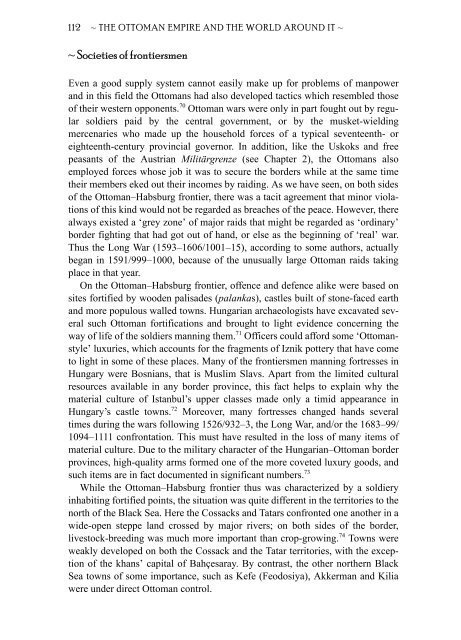The Ottoman Empire and the World Around It - Course Information
The Ottoman Empire and the World Around It - Course Information
The Ottoman Empire and the World Around It - Course Information
You also want an ePaper? Increase the reach of your titles
YUMPU automatically turns print PDFs into web optimized ePapers that Google loves.
112 ~ THE OTTOMAN EMPIRE AND THE WORLD AROUND IT ~<br />
~ Societies of frontiersmen<br />
Even a good supply system cannot easily make up for problems of manpower<br />
<strong>and</strong> in this field <strong>the</strong> <strong>Ottoman</strong>s had also developed tactics which resembled those<br />
of <strong>the</strong>ir western opponents. 70 <strong>Ottoman</strong> wars were only in part fought out by regular<br />
soldiers paid by <strong>the</strong> central government, or by <strong>the</strong> musket-wielding<br />
mercenaries who made up <strong>the</strong> household forces of a typical seventeenth- or<br />
eighteenth-century provincial governor. In addition, like <strong>the</strong> Uskoks <strong>and</strong> free<br />
peasants of <strong>the</strong> Austrian Militärgrenze (see Chapter 2), <strong>the</strong> <strong>Ottoman</strong>s also<br />
employed forces whose job it was to secure <strong>the</strong> borders while at <strong>the</strong> same time<br />
<strong>the</strong>ir members eked out <strong>the</strong>ir incomes by raiding. As we have seen, on both sides<br />
of <strong>the</strong> <strong>Ottoman</strong>–Habsburg frontier, <strong>the</strong>re was a tacit agreement that minor violations<br />
of this kind would not be regarded as breaches of <strong>the</strong> peace. However, <strong>the</strong>re<br />
always existed a ‘grey zone’ of major raids that might be regarded as ‘ordinary’<br />
border fighting that had got out of h<strong>and</strong>, or else as <strong>the</strong> beginning of ‘real’ war.<br />
Thus <strong>the</strong> Long War (1593–1606/1001–15), according to some authors, actually<br />
began in 1591/999–1000, because of <strong>the</strong> unusually large <strong>Ottoman</strong> raids taking<br />
place in that year.<br />
On <strong>the</strong> <strong>Ottoman</strong>–Habsburg frontier, offence <strong>and</strong> defence alike were based on<br />
sites fortified by wooden palisades (palankas), castles built of stone-faced earth<br />
<strong>and</strong> more populous walled towns. Hungarian archaeologists have excavated several<br />
such <strong>Ottoman</strong> fortifications <strong>and</strong> brought to light evidence concerning <strong>the</strong><br />
way of life of <strong>the</strong> soldiers manning <strong>the</strong>m. 71 Officers could afford some ‘<strong>Ottoman</strong>style’<br />
luxuries, which accounts for <strong>the</strong> fragments of Iznik pottery that have come<br />
to light in some of <strong>the</strong>se places. Many of <strong>the</strong> frontiersmen manning fortresses in<br />
Hungary were Bosnians, that is Muslim Slavs. Apart from <strong>the</strong> limited cultural<br />
resources available in any border province, this fact helps to explain why <strong>the</strong><br />
material culture of Istanbul’s upper classes made only a timid appearance in<br />
Hungary’s castle towns. 72 Moreover, many fortresses changed h<strong>and</strong>s several<br />
times during <strong>the</strong> wars following 1526/932–3, <strong>the</strong> Long War, <strong>and</strong>/or <strong>the</strong> 1683–99/<br />
1094–1111 confrontation. This must have resulted in <strong>the</strong> loss of many items of<br />
material culture. Due to <strong>the</strong> military character of <strong>the</strong> Hungarian–<strong>Ottoman</strong> border<br />
provinces, high-quality arms formed one of <strong>the</strong> more coveted luxury goods, <strong>and</strong><br />
such items are in fact documented in significant numbers. 73<br />
While <strong>the</strong> <strong>Ottoman</strong>–Habsburg frontier thus was characterized by a soldiery<br />
inhabiting fortified points, <strong>the</strong> situation was quite different in <strong>the</strong> territories to <strong>the</strong><br />
north of <strong>the</strong> Black Sea. Here <strong>the</strong> Cossacks <strong>and</strong> Tatars confronted one ano<strong>the</strong>r in a<br />
wide-open steppe l<strong>and</strong> crossed by major rivers; on both sides of <strong>the</strong> border,<br />
livestock-breeding was much more important than crop-growing. 74 Towns were<br />
weakly developed on both <strong>the</strong> Cossack <strong>and</strong> <strong>the</strong> Tatar territories, with <strong>the</strong> exception<br />
of <strong>the</strong> khans’ capital of Bahçesaray. By contrast, <strong>the</strong> o<strong>the</strong>r nor<strong>the</strong>rn Black<br />
Sea towns of some importance, such as Kefe (Feodosiya), Akkerman <strong>and</strong> Kilia<br />
were under direct <strong>Ottoman</strong> control.


